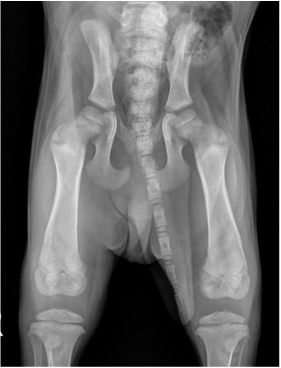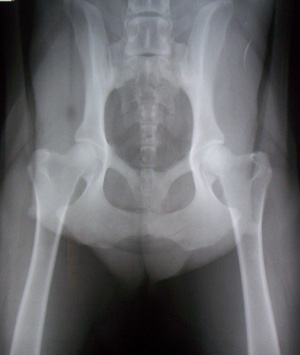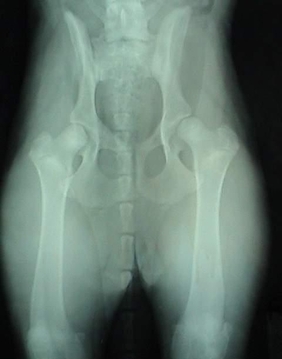About Canine Hip Dysplasia
Canine Hip Dysplasia is a common structural problem affecting the canine population. It is a complex, inherited, polygenic trait that affects a large percentage of both purebred and mixed breed dogs. Dogs predisposed to hip dysplasia are born with normal hips, but quickly develop subluxation of the femoral head. Degenerative joint disease follows typically within the first year of a dog's life.
At this point in time, there is no way to accurately genetically test a dog for dysplasia. Selective breeding of only normal dogs with normal littermates, parents, and grandparents is the recommended method of reducing the incidence rate in the general population. When you are in the market for a new puppy, demand to see all heath screenings for both parents. This can be in the form of OFA or PennHip exam certificates. OFA hips are scored by three radiologists and passing scores are rated as Fair, Good, & Excellent. OFA failing scores are rated as Borderline, Mild, Moderate, and Severe. PennHip, on the other hand, rates a dog with a “Distraction Index” (DI) number between 0.00 and 1.00. The tightest joint a joint can be is 0.00, and the loosest is 1.00. A score of 0.30 corresponds to very tight (healthy) hips for any breed of dog, and a score 0.70 corresponds to very loose (dysplasic) hips.
At this point in time, there is no way to accurately genetically test a dog for dysplasia. Selective breeding of only normal dogs with normal littermates, parents, and grandparents is the recommended method of reducing the incidence rate in the general population. When you are in the market for a new puppy, demand to see all heath screenings for both parents. This can be in the form of OFA or PennHip exam certificates. OFA hips are scored by three radiologists and passing scores are rated as Fair, Good, & Excellent. OFA failing scores are rated as Borderline, Mild, Moderate, and Severe. PennHip, on the other hand, rates a dog with a “Distraction Index” (DI) number between 0.00 and 1.00. The tightest joint a joint can be is 0.00, and the loosest is 1.00. A score of 0.30 corresponds to very tight (healthy) hips for any breed of dog, and a score 0.70 corresponds to very loose (dysplasic) hips.
How to Protect Your Puppy's Hips
 8 week old puppy hips
8 week old puppy hips
Although HD is primarily caused by bad genes, developmental dysplasia may be caused by a number of environmental factors. Inadequate nutrition during key growth periods and over exercising of puppies are two major factors. For instance, the photo on the left is an X-ray of a puppy at 8 weeks old-- look to see how far the bones have to grow to just become proper bony joints, let alone become strong articulating joints that have correct feedback into the brain!
To prevent developmental HD, maintain your dog at a healthy weight. Food intake should be regulated to maintain a slender figure with the ribs and dorsal vertebrae easily felt, but not visible. We strongly advise feeding your puppy a GOOD QUALITY dog food. Feeding a growing puppy a diet too high in protein and calcium (while it seems like a good idea) encourages fast growth and can actually increase the probability of HD. Foods too low in protein, vitamin C, and calcium do not contain the proper nutrients and can also lead to HD.
Too much exercise for a growing puppy can lead to HD when the dog ages. Puppies under 18 months old should not be encouraged to jump, jog/run for extended periods on hard surfaces, or run up and down stairs until their bones and joints are fully developed. Puppies should also not be spayed or neutered before their key growth plates are sealed at approximately 18 months!
Though we are NOT saying you should place a protective bubble around your puppy to keep him out of harms way, please be careful with your puppy so your dog's joints will last well as they age! We strive to produce the most excellent dogs in whatever you wish to participate in with your new furry companion. Whether that be hunting, conformation, juniors, flyball, agility, or just being a well loved pet... Here at Apricity Kennel, we want your new puppy's goals to come true.
If you look at the image below on the left, that is what a dog's hips should look like once they grow up. Notice how tight those joints are. The femoral head fits snugly into the socket which gives the ball a nice amount of coverage. Now look at the below image on the right. This what a dog looks like when they have hip dysplasia. Notice the difference? Look how broken the joint itself looks! There is no rounded socket anymore and the ball is grinding against bone because of the cartilage loss. We can't stress enough the importance to keep your new puppy safe from injury while his little bones and joints are still forming. The dog on the right is living in pain, and it will just get worse as he ages. At Apricity Kennel, longevity is key!
To prevent developmental HD, maintain your dog at a healthy weight. Food intake should be regulated to maintain a slender figure with the ribs and dorsal vertebrae easily felt, but not visible. We strongly advise feeding your puppy a GOOD QUALITY dog food. Feeding a growing puppy a diet too high in protein and calcium (while it seems like a good idea) encourages fast growth and can actually increase the probability of HD. Foods too low in protein, vitamin C, and calcium do not contain the proper nutrients and can also lead to HD.
Too much exercise for a growing puppy can lead to HD when the dog ages. Puppies under 18 months old should not be encouraged to jump, jog/run for extended periods on hard surfaces, or run up and down stairs until their bones and joints are fully developed. Puppies should also not be spayed or neutered before their key growth plates are sealed at approximately 18 months!
Though we are NOT saying you should place a protective bubble around your puppy to keep him out of harms way, please be careful with your puppy so your dog's joints will last well as they age! We strive to produce the most excellent dogs in whatever you wish to participate in with your new furry companion. Whether that be hunting, conformation, juniors, flyball, agility, or just being a well loved pet... Here at Apricity Kennel, we want your new puppy's goals to come true.
If you look at the image below on the left, that is what a dog's hips should look like once they grow up. Notice how tight those joints are. The femoral head fits snugly into the socket which gives the ball a nice amount of coverage. Now look at the below image on the right. This what a dog looks like when they have hip dysplasia. Notice the difference? Look how broken the joint itself looks! There is no rounded socket anymore and the ball is grinding against bone because of the cartilage loss. We can't stress enough the importance to keep your new puppy safe from injury while his little bones and joints are still forming. The dog on the right is living in pain, and it will just get worse as he ages. At Apricity Kennel, longevity is key!
PuppyCulture™ has an EXCELLENT booklet and chart called "Puppy Fitness that Fits the Puppy." We highly recommend all of our puppy buyers to follow these exercise guidelines with their growing puppy!


